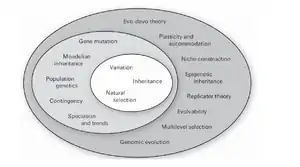Extended evolutionary synthesis
Extended evolutionary synthesis also known as the extended synthesis is an extension of the modern evolutionary synthesis.
| We're all Homo here Evolution |
| Relevant Hominids |
| A Gradual Science |
| Plain Monkey Business |
v - t - e |
Introduction
The neo-Darwinian modern synthesis was developed in the period from 1930 to 1950 due to the reconciliation of evolution by natural selection and the incorporation of Mendelian and population genetics. It has been over 60 years and evolution today includes mechanisms and even entire new fields that were not part of the foundational structure of the modern synthesis. Some scientists have proposed that ingredients of an extended synthesis are gradually becoming visible and that the modern synthesis as it stands is incomplete and needs to be extended.[1]
In 1978 Michael JD White
Phenotypic plasticity and the work of Conrad Hal Waddington on genetic assimilation has also been incorporated into the extended evolutionary synthesis.[5]
Altenberg Conference

In 2008 sixteen scientists met at the Konrad Lorenz Institute for Evolution and Cognition in Altenberg, Austria to discuss an extended synthesis. The group which included scientists such as Massimo Pigliucci, Eva Jablonka and Gerd B. Müller explained that there have been calls for an expansion of the synthesis framework through the integration of more recent achievements in evolutionary theory and that new approaches have opened up new theoretical horizons, with new possibilities for integration and expansion in evolutionary theory, such as Evo-devo, Niche Construction
The biolologist Gert Korthof
“”Neo-Darwinism plus molecular genetics (Watson & Crick, 1953). That is about 50 years ago. Furthermore, there are or probably will be included: developmental biology (evo-devo), genomics, epigenetics, ecology, symbiosis, life history, hybridization, horizontal gene transfer, systems biology, Earth System Science (including Niche Construction and Gaia), origin of life, astrobiology, sociobiology (incl. evolutionary psychology), evolution of the brain and mind (consciousness).[7] |
The extended evolutionary synthesis accepts many tenets of the classical framework from the neo-Darwinian synthesis yet in certain areas extends the framework into new fields. The extended synthesis is not anti-Darwinian, it merely says that the neo-Darwinian synthesis is incomplete. Massimo Pigliucci published Evolution - the Extended Synthesis (2011) which included contributions from sixteen leading evolutionary biologists and philosophers of science.
Reception
In 1981 G. Ledyard Stebbins
External links
References
- Evolution—the Extended Synthesis
- Heralding a New Synthesis Modes of Speciation. by M. J. D. White Review by: Dennis R. Parnell Systematic Botany , Vol. 3, No. 1 (Spring, 1978), p. 126
- Is a New and General Theory of Evolution Emerging? Stephen Jay Gould Paleobiology , Vol. 6, No. 1 (Winter, 1980), pp. 119-130 Online also see Darwinism and the Expansion of Evolutionary Theory Stephen Jay Gould Science , New Series, Vol. 216, No. 4544 (Apr. 23, 1982), pp. 380-387 Online
- A More Modern Synthesis by David Jablonski
- Phenotypic plasticity and evolution by genetic assimilation by Massimo Pigliucci, Courtney J. Murren and Carl D. Schlichting
- Toward an Extended Evolutionary Synthesis
- Towards The Third Evolutionary Synthesis
- Is a New Evolutionary Synthesis Necessary? G. Ledyard Stebbins and Francisco J. Ayala Science , New Series, Vol. 213, No. 4511 (Aug. 28, 1981), pp. 967-971 Online
- The Neo-Modern Synthesis: The Confluence of New Data and Explanatory Concepts Evolution—the Extended Synthesis by Massimo Pigliucci; Gerd B. Müller. Michael J. Wade, BioScience , Vol. 61, No. 5 (May 2011), pp. 407-408
- Are we ready for an “extended evolutionary synthesis”?
- Jerry Coyne and the Extended evolutionary Synthesis
- Evolution: The Extended Synthesis also see Full Review Online
- https://royalsocietypublishing.org/doi/10.1098/rsfs.2016.0145
- https://royalsocietypublishing.org/doi/full/10.1098/rspb.2016.2864